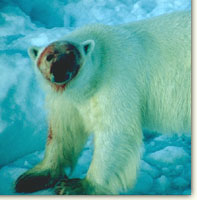![]()

![]() What is your animals name?
What is your animals name?
All bears belong to this family. The family is divided into three subfamilies, Ursinae (black bears, brown bears, polar bears, sloth bears, and sun bears), Tremarctinae (spectacled bears), and Ailuropodinae (giant pandas).
![]() Where do they live?
Where do they live?
Polar bears are found throughout the circumpolar Arctic.
![]() How does your animal look after its young?
How does your animal look after its young?
Nursing.
a. Female polar bears have four
mammary glands. Mothers nurse their cubs in a sitting position, or lying down on their
side or back.
b. During their first few weeks
of life, polar bear cubs nurse most of the time and stay close to their mother to keep
warm.
c. For the next three or four
months the cubs nurse as often as six times a day. The length and number of nursings
gradually decreases as the cubs grow older.
d. Mother polar bears nurse their
cubs for as long as 30 months. Some cubs stop nursing as young as 18 months of age, but
remain with their mothers for survival until they are 30 months old.
e. The average fat content of polar bear milk is 33%, similar to the milk fat of other marine mammals
2.Mother polar bears are extremely protective of their young, even risking their own lives in their cubs' defense.
A cute picture of a baby polar bear click here
![]() What
age do your animal live to?
What
age do your animal live to?
Polar bears can live 20 to 30 years, but only a small proportion of polar bears live past 15 to 18 years.The oldest known polar bear in the Arctic lived 32 years. The oldest known polar bear in a zoological park lived 41 years.
![]() What does your animal eat?
What does your animal eat?
Polar bears feed mainly on ringed seals and bearded seals. Depending upon their location, they also eat harp and hooded seals and scavenge on carcasses of beluga whales, walruses, narwhals, and bowhead whales. When seals are unavailable, polar bears eat other marine mammals, reindeer, small rodents, sea birds, ducks, fish, eggs, vegetation (including kelp), berries, and human garbage. A polar bear's stomach can hold an estimated 15% to 20% of its body weight. It can assimilate 84% of the protein and 97% of the fat it eats. Polar bears need an average of 2 kg (4.4 lb.) of fat per day to survive. A ringed seal weighing 55 kg (121 lb.) could provide up to eight days of energy for a polar bear

This Polar Bear had a nice lunch!
(I'm glad it wasn't me)
Did you know?
The skin of a polar bear
is black. This helps them to absorb more of the heat from the sun. Most adult bears die
from being killed by people. Many people are trying to save bears. Polar bears are found
throughout the Arctic.
[Canada houses about 40% of the world's polar bear population!] There's only about 25,000
polar bears left on the planet.Male polar bears can weight upto 2,000 lbs! Male polar
bears have been measured upto 3m in length. Polar
bears DO have a tail.
[It's a teeny-weeny one, though. :) About 6 cm long.] The claws of the polar bear are
awesome. They could easily shred you or I to pieces!
view my gallery
Here is a bear big hug
If you want to see a movie of a polar bear click here
This page was constructed by Daniel Jackaman Yr. 5 Mr. Briggs December 1998
Resources
http://www.seaworld.org/polar_bears/pbindex.html
http://www.nature-net.com/bears/pics/m_polar.gif
And a book from the library
| Hallet Cove South Primary Information:Daniel Jackaman HTML constructed by Daniel Jackaman December 1998 |
Kamo
Elementary School
|
Central Elementary
School
|